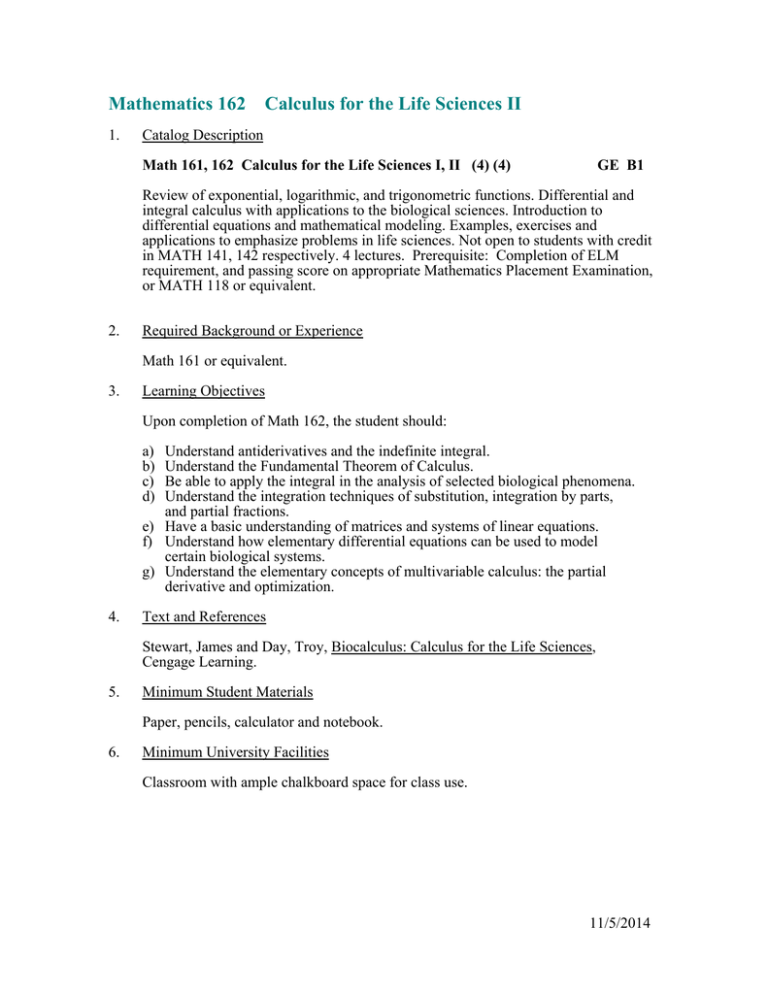Mathematics 162 Calculus for the Life Sciences...
advertisement

Mathematics 162 1. Calculus for the Life Sciences II Catalog Description Math 161, 162 Calculus for the Life Sciences I, II (4) (4) GE B1 Review of exponential, logarithmic, and trigonometric functions. Differential and integral calculus with applications to the biological sciences. Introduction to differential equations and mathematical modeling. Examples, exercises and applications to emphasize problems in life sciences. Not open to students with credit in MATH 141, 142 respectively. 4 lectures. Prerequisite: Completion of ELM requirement, and passing score on appropriate Mathematics Placement Examination, or MATH 118 or equivalent. 2. Required Background or Experience Math 161 or equivalent. 3. Learning Objectives Upon completion of Math 162, the student should: a) b) c) d) Understand antiderivatives and the indefinite integral. Understand the Fundamental Theorem of Calculus. Be able to apply the integral in the analysis of selected biological phenomena. Understand the integration techniques of substitution, integration by parts, and partial fractions. e) Have a basic understanding of matrices and systems of linear equations. f) Understand how elementary differential equations can be used to model certain biological systems. g) Understand the elementary concepts of multivariable calculus: the partial derivative and optimization. 4. Text and References Stewart, James and Day, Troy, Biocalculus: Calculus for the Life Sciences, Cengage Learning. 5. Minimum Student Materials Paper, pencils, calculator and notebook. 6. Minimum University Facilities Classroom with ample chalkboard space for class use. 11/5/2014 Math 162, page 2. 7. Content and Method Content No. of Lectures 4. Applications of Derivatives 4.6 Antiderivatives 1 5. Integrals 5.1 Areas, Distances, and Pathogenesis 5.2 The Definite Integral 5.3 The Fundamental Theorem of Calculus 5.4 The Substitution Rule 5.5 Integration by Parts 5.6 Partial Fractions 9 6. Applications of Integrals 6.1 Areas Between Curves 6.3 Further Applications to Biology 3 7. Differential Equations 7.1 Modeling with Differential Equations 7.2 Phase Plots, Equilibria, and Stability 7.3 Direction Fields and Euler’s Method 7.4 Separable Equations 8 8. Vectors and Matrix Models 8.1 Coordinate Systems 8.4 Matrix Algebra 8.6 The Inverse and Determinant of a Matrix 4 9. Multivariable Calculus 9.1 Functions of Several Variables 9.2 Partial Derivatives 9.6 Maximum and Minimum Values 5 ____ Total Remarks 30 a. Additional topics may be chosen at the discretion of the instructor. b. When at all possible, use applications from the life sciences to illustrate concepts from calculus. c. The chapter on differential equations is very important. 11/5/2014 Math 162, page 3. Method Largely lecture with blackboard illustration of the discussion along with supervised work and individual conferences. Most examples, exercises and applications will be taken from the life sciences. 8. Methods of Assessment The primary methods of assessment are, in decreasing order of importance: essay examinations, quizzes and homework. Typically, there will be two or three hour-long examinations during the quarter, and a comprehensive final examination. Students are required to show their work, and are graded not only on the correctness of their answers, but also on their understanding of the concepts and techniques. Quizzes are typically given once or twice a week to provide a spot check of student learning. Homework is required daily. 11/5/2014

